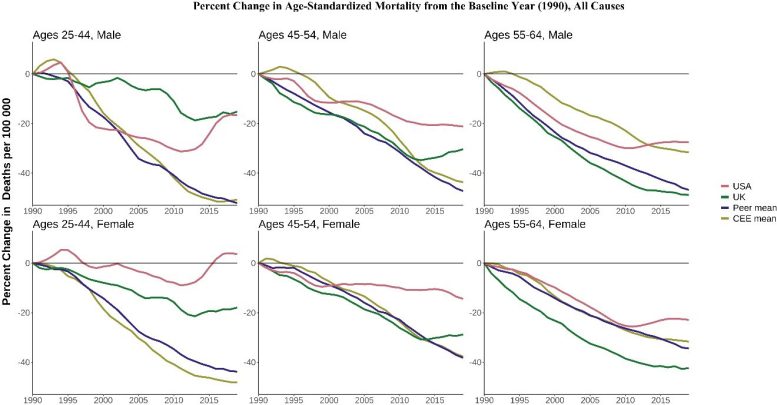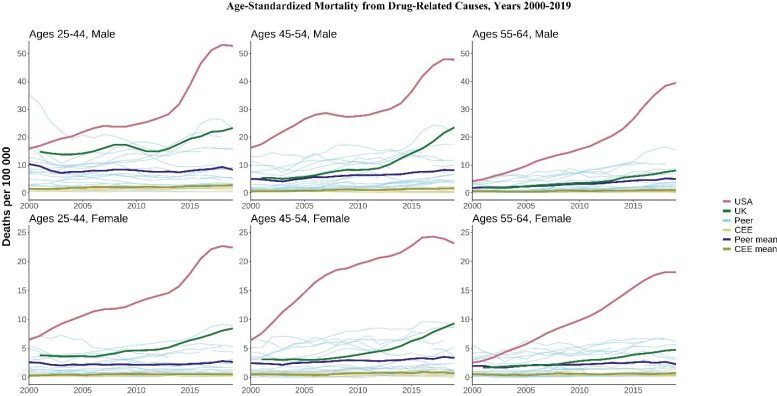
A study reveals that midlife mortality rates in the US and UK are worsening compared to other high-income countries, with preventable causes such as drug overdoses driving this trend in the US. The UK faces similar challenges, particularly among younger women, indicating significant room for improvement in public health policies and interventions.
A new study by researchers at the Leverhulme Centre for Demographic Science (LCDS) and Princeton University reveals that US working-age adults are dying at higher rates than their peers in high-income countries; the UK is also falling behind. The study is published today in the International Journal of Epidemiology.
Using annual mortality data from the World Health Organization Mortality Database, the study compared trends in midlife mortality for adults aged 25-64 years between 1990 and 2019 across 15 major causes of death in 18 high-income countries, including the US and UK, and seven Central and Eastern European countries.
Over the past three decades, the study found that most of these countries have experienced significant declines in midlife mortality from all possible causes of death, known as all-cause mortality. US improvements, however, were slower and interrupted by recent periods of stalling and reversals, depending on age and sex. As a result, by 2019, the US saw all-cause mortality rates that were 2.5 times higher than the average of other high-income countries studied.

Age-standardized mortality from drug-related causes from 2000-2019. CEE, Central and Eastern European country. ‘Peer’ indicates a high-income country comparable to the USA. Credit: Oxford Population Health
Worsening midlife mortality in the US was driven by several causes of death, including highly preventable ones such as transport accidents, homicide, suicide, and drug overdoses. For example, drug-related deaths in the US increased up to 10-fold (depending on sex and age group combination) between 2000 and 2019, diverging tremendously from other countries.
Comparative Analysis and UK’s Position
Dr Katarzyna Doniec, corresponding author of the study and Postdoctoral Researcher at LCDS and the Demographic Science Unit said, ‘Over the past three decades midlife mortality in the US has worsened significantly compared to other high-income countries, and for the younger 25 to 44 year old age-group in 2019 it even surpassed midlife mortality rates for Central and Eastern European countries. This is surprising, given that not so long ago some of these countries experienced high levels of working-age mortality, resulting from the post-socialist crisis of the 1990s.’
The study highlights the health disadvantage of younger US females aged 25-44 years old who were the only group across the 25 countries studied to experience higher mortality rates in 2019 than in 1990.

Percentage change in all-cause mortality rates since 1990. CEE, Central and Eastern European country. ‘Peer’ indicates a high-income country comparable to the USA. Credit: Oxford Population Health
The UK is also falling behind its high-income peers with midlife mortality increasing for people aged 45-54, and death rates among 25-54 year olds stagnating instead of improving. Midlife mortality among 25-44-year-olds also rose in Canada since 2013 alongside small increases for males of the same age range in Poland and Sweden, although these increases were far smaller than in the US.
While the UK performed relatively well on external causes of death such as suicide, homicide, and traffic accidents, this was countered by stalling improvements in cardiovascular disease and cancer, and increasing drug deaths. The study also found that by 2019 younger females (25-44 year olds) in the UK fared worse than all high-income peers, except the US, and even some of the Central and Eastern European countries.
Professor Jennifer Dowd, lead author and Deputy Director of LCDS and the Demographic Science Unit said, ‘Our study adds to the evidence that UK mortality is increasingly diverging from its high-income peers, especially for younger women. The causes of this worsening health will be important to understand going forward.’
The study concludes that mortality declines witnessed in other high-income countries imply significant room for mortality improvement in both the US and UK. The study did not cover the years of the COVID-19 pandemic, when the life expectancy gap between the US and high-income countries widened further.
Reference: “US exceptionalism? International trends in midlife mortality” by Jennifer Beam Dowd, Katarzyna Doniec, Luyin Zhang and Andrea Tilstra, 21 March 2024, International Journal of Epidemiology.
DOI: 10.1093/ije/dyae024









USA and UK have similar diet problems,,,,not sufficient nutrients in the food that is grown, and then mostly processed out.
We do well into the late 70’s but then the lack of nutrients brings on death.
The reason our lifespan has been generous is that most of the older folks started life when the food was good, and the food industry did not have as much opportunity to process it to death.
the UK and US women are drunken skeets
Again, for some, as a now eighty year old American male still in only relative good health, I first wrote the US FDA (with replies) of my early lay findings of connections between food allergies, added MSG, chronic disease and the then still rather recently announced “obesity epidemic” in October of 2005 (obviously, now, in-vain). Since, I have written thousands of more authoritative, qualified and/or resourceful professional others with mostly similar results. In recent years I’ve come to identify the three leading causes of so much premature mortality in the US as: 1) undiagnosed food (minimally) allergies (e.g., Dr. Arthur F. Coca, by 1935), 2) added FDA approved food poisoning (e.g., soy [since the late 1960s], added MSG [approved for expanded use in 1980], minimally) and 3) related/resultant medical errors (announced by Johns Hopkins researchers in May of 2016 to be the third leading cause of death in the US). Simply put, mainstream medicine in the US is still “dark-ages” (e.g., high-tech blood-letting and potions). As to the higher prevalence of US female mortality, breast cancers caused by soy being processed more cheaply with toxic hexane with some residue may help to explain that.